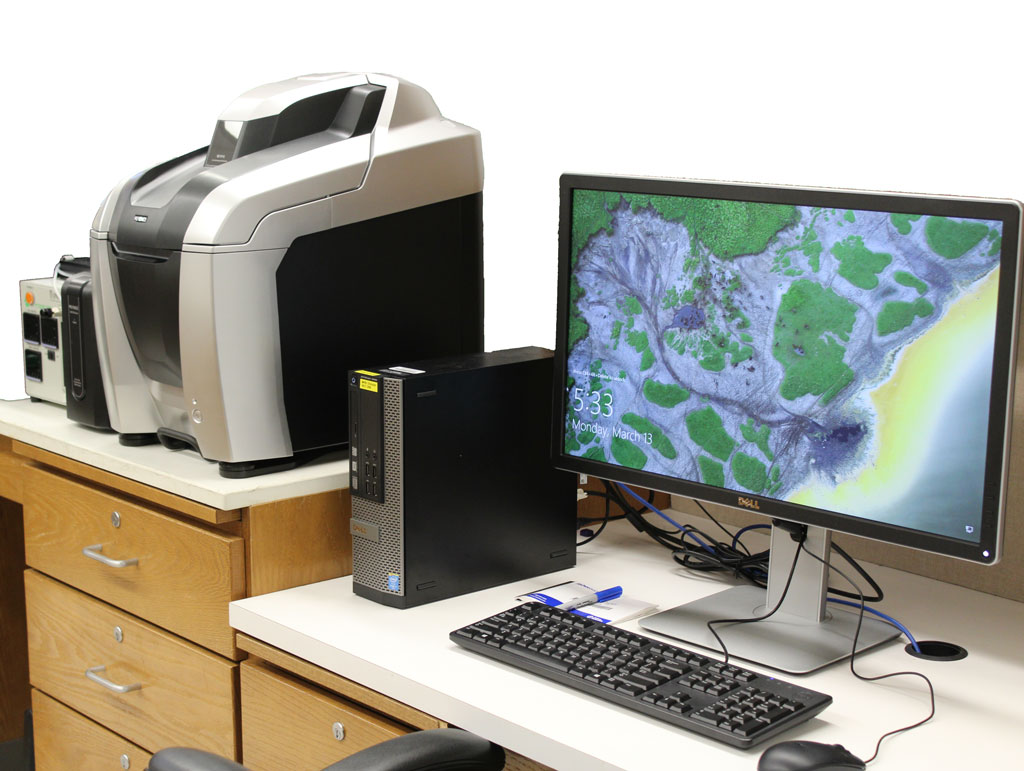MRB Facilities and Equipment
The Molecular Radiation Biology division has nearly 40,000 square feet of dedicated space conveniently located in a modern facility. We have a dedicated laboratory coordinator who assists in monitoring core equipment and currently maintain more than 100 PC and Macintosh computer systems.
Within our dedicated space we have 12 research labs and nine tissue culture rooms for a total of 22 tissue culture hoods. Each principal investigator is provided a separate office space. In addition, we have two rooms dedicated for microscope use. One room houses a Zeiss LSM 510 Confocal Microscope and a Zeiss-Axiovert microscope, another room houses three Zeiss microscopes and the other houses one Olympus fluorescent microscope. All microscopes are equipped with dedicated cameras and computers.
In addition, we have the following specialized rooms within our facility:
- Temperature specific rooms: one -20ºC room, three 4ºC rooms, and one 37ºC room
- Equipment gallery housing three centrifuges, five cryo freezers, and 16 ultralow freezers
- Additional room housing a state-of-the-art CO2 system
- Room housing three autoclaves, one dishwasher, and one oven
- Darkroom
Equipment
AKTA pure Chromatography System: For protein purification and high-resolution analysis.
Akoya CODEX: A comprehensive solution for spatially resolved, multiplexed immunofluorescence.
Bio-Rad CFX90 Touch™ Real-Time PCR Detection System: Six-channel real-time PCR instruments with precise temperature control to deliver sensitive, reliable detection for singleplex or multiplex reactions.
Bio-Rad QX200 Droplet Digital PCR System: Provides quantification of target DNA or RNA molecules for EvaGreen or probe-based digital PCR applications.
Bio-Rad T100 Thermal Cycler: For PCR, gene cloning and analysis, gene expression analysis, mutational analysis, and cycle sequencing.
BioTel Cytatino 5 Cell Imaging Multi-Mode Reader: Multi-mode detection modules combine automated digital microscopy and conventional microplate detection in a configurable, upgradable platform, include filter- and monochromator-based fluorescence detection, luminescence and UV-Vis absorbance detection.
BioTel BioSpa 8 Automated Incubator: It links BioTek readers and imagers together with washers and dispensers for full workflow automation of up to 8 microplates or other labware.
Colcount Automated Colony Counter: For clonogenic survival analysis.
Custom BioGenic Systems V-1500, V-3000A and Thermo CryoPlus 3 (x2) Liquid Nitrogen Freezers: For frozen sample storage at liquid nitrogen temperature.
FlowSight® Imaging Flow Cytometer: This flow cytometer produces up to 12 images of each cell.
HypOxygen H35 HypOxystation and Whitley i2 Instrument Workstation: Consists of both cell incubator and workstation to allow a controlled environment for cell manipulation under normoxic, hypoxic, and anoxic conditions.
Keyence BZ-X700: An all-in-one fluorescent microscope for automated high-content imaging in fixed and live cells. The system also equips with analytic programs for fast and reliable image analyses.

Leica CM3050S Motorized Cryostat and SM2000R Sliding Microtome: Tissue sectioning.
Malvern Panalytical NanoSight NS300: It provides an easy-to-use, reproducible platform for nanoparticle characterization that allows rapid analysis of the size distribution and concentration of all types of nanoparticles from 0.01 - 1 µm in diameter, depending on the instrument configuration and sample type.
NanoDrop 2000 UV-Vis Spectrophotometer: For measuring peptides, DNA, RNA, or protein concentrations with minimum sample volume.
Nucleofector II Device: For DNA transfection into cells, up to 90 percent transfection efficiency.
ProteinSimple FluorChem M Multifluor System: For chemiluminescent imaging.
ProteinSimple NanoPro 1000 Simple Western Charge Assays: Provides a protein/phospho-protein quantitative assay. This instrument is also capable of analyzing drug actions in fine needle aspirates (FNAs) taken from xenografts, and requires as few as 25 cells per assay.
ProteinSimple Wes: The instrument lets the users separate and analyze proteins by size from 2 kDa to 440 kDa. It can run up to 25 samples in just three hours.
Seahorse XFe24 Analyzer: Measures OCR and ECAR of live cells in a 24-well plate format, which provides key indicators of mitochondrial respiration and glycolysis and a systems-level view of cellular metabolic function in cultured cells, islets, and ex vivo samples.
Small Animal Cabinet X-Ray Irradiator: X-RAD 320, a self-contained X-ray irradiation system for the use of animal studies, with maximum 320 kV output. A fee of $50/hour will be charged to users from outside of the Department. For more information, please contact Debabrata Saha, Ph.D. debabrata.saha@utsouthwestern.edu
SORVALL Discovery 90SE Ultracentrifuge
SORVALL RC-6 Superspeed Refrigerated Centrifuge
Thermo Scientific™ CytoSpin™ 4 Cytocentrifuge: Designed for thin-layer cell preparation.
Ultrospec 3300 Spectrophotometer: To measure the amount of a chemical substance absorbs light by passing a beam of light through the sample. It can read a wavelength range of 190 to 1,100 nm.
Z1 Analyzer and Z2 Analyzer (x2): For cell culture count including size distribution of the cell population.
Zeiss Axiovert 200 and Axiovert 200M Inverted Research-Grade Microscope: Configured to perform fluorescence microscopy as well as differential-interference contrast and phase-contrast microscopy. Images may be acquired via a Zeiss AxioCam HRC color CCD camera.
Zeiss AxioImager M2 Microscope: Configured to perform fluorescence microscopy as well as differential-interference contrast and phase-contrast microscopy. Images may be acquired via a Zeiss AxioCam MRm B/W camera or an AxioCam ICc color camera.
Zeiss LSM 510 META Confocal Microscope: Equipped with a Zeiss ConfoCor 3 FSC module, an external MicroPoint Nitrogen Laser, and a stage heater for live cell imaging analysis. It is used to investigate the temporal and kinetics of DNA damage sensing and signaling processes in live cells.
